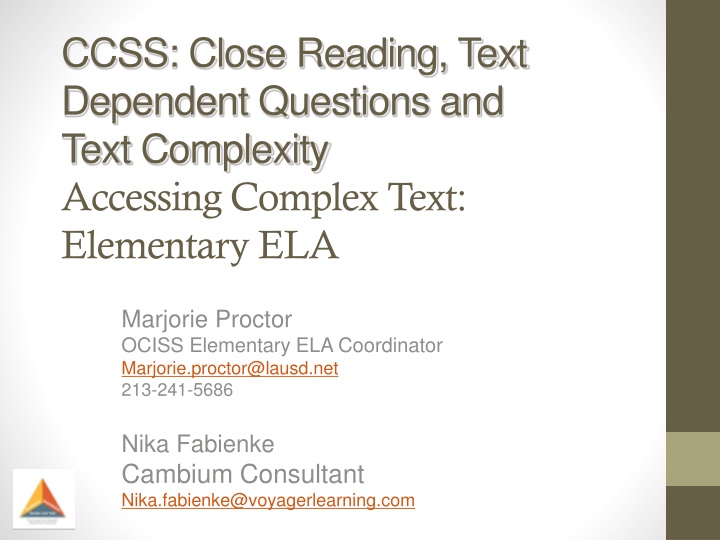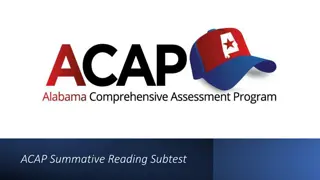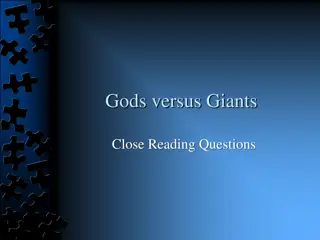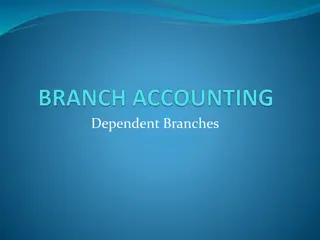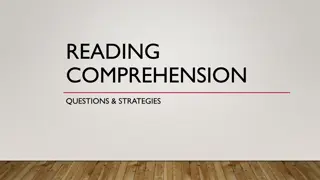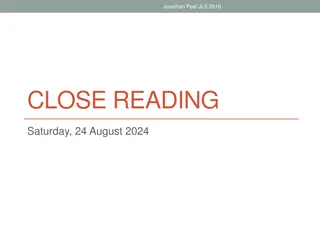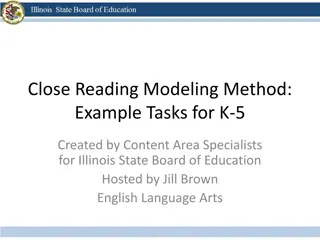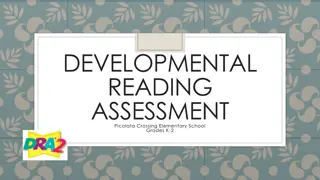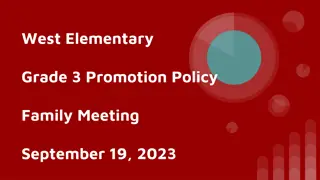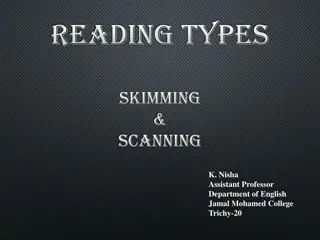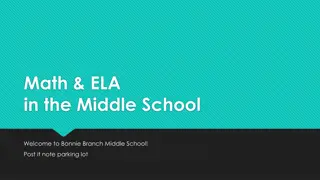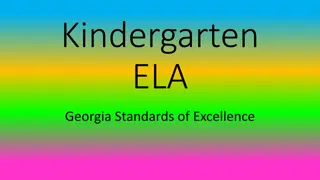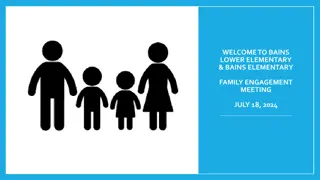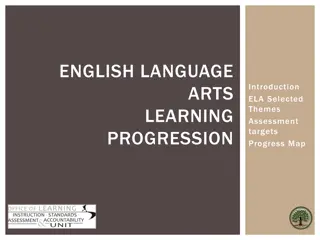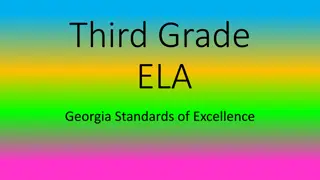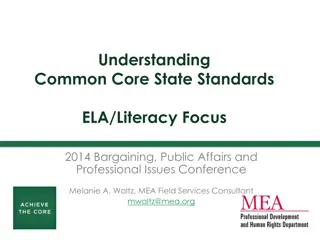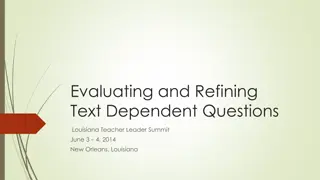Close Reading and Text Dependent Questions in Elementary ELA
Participants will review the purpose of close reading and text-dependent questions, define and identify the purpose of complex text, and plan instruction using strategies to ensure student success in accessing grade-level appropriate complex text. The session focuses on college-prepared and career-ready students, teaching frameworks, and the Common Core standards.
Download Presentation

Please find below an Image/Link to download the presentation.
The content on the website is provided AS IS for your information and personal use only. It may not be sold, licensed, or shared on other websites without obtaining consent from the author.If you encounter any issues during the download, it is possible that the publisher has removed the file from their server.
You are allowed to download the files provided on this website for personal or commercial use, subject to the condition that they are used lawfully. All files are the property of their respective owners.
The content on the website is provided AS IS for your information and personal use only. It may not be sold, licensed, or shared on other websites without obtaining consent from the author.
E N D
Presentation Transcript
CCSS: Close Reading, Text Dependent Questions and Text Complexity Accessing Complex Text: Elementary ELA Marjorie Proctor OCISS Elementary ELA Coordinator Marjorie.proctor@lausd.net 213-241-5686 Nika Fabienke Cambium Consultant Nika.fabienke@voyagerlearning.com
Objective Participants will Review the purpose for Close Reading and the use of Text Dependent Questions Define and Identify the purpose for Complex Text Plan the instruction using close reading strategies and text-dependent questions to ensure success for all our students at accessing grade-level appropriate complex text
College-Prepared and Career-Ready Students Master Plan (The Who) Teaching & Learning Framework (The How) Common Core (The What) 3
What you Know! What is your level of understanding of the role of Complex Text in the Common Core State Standards for Literacy? 4
CCSS: Review the Definitions Read Principles Informing Close Reading. As you read, consider the following: Why is it IMPORTANT to teach students to use the strategy of Close Reading? What ROLE do text Dependent Questions play in Reading Comprehension?
CCR Anchor Standards 1. Read closely to determine what the text says explicitly and to make logical inferences from it; cite specific textual evidence when writing or speaking to support conclusions drawn from the text. 2. Determine central ideas or themes of a text and analyze their development; summarize the key supporting details and ideas. 3. Analyze how and why individuals, events, and ideas develop and interact over the course of a text. 4. Interpret words and phrases as they are used in a text, including determining technical, connotative, and figurative meanings, and analyze how specific word choices shape meaning or tone. 5. Analyze the structure of texts, including how specific sentences, paragraphs, and larger portions of the text (e.g., a section, chapter, scene, or stanza) relate to each other and the whole. 6. Assess how point of view or purpose shapes the content and style of a text. 7. Integrate and evaluate content presented in diverse media and formats, including visually and quantitatively, as well as in words.1 8. Delineate and evaluate the argument and specific claims in a text, including the validity of the reasoning as well as the relevance and sufficiency of the evidence. 9. Analyze how two or more texts address similar themes or topics in order to build knowledge or to compare the approaches the authors take. 10. Read and comprehend complex literary and informational texts independently and proficiently. 6
CCR Anchor Standard 1- Reading 7 Key Ideas and Details Read closely Read closely to determine what the text says explicitly and to make logical inferences from it; cite specific textual evidence when writing or speaking to support conclusions drawn from the text. This standard relates directly to close reading and text dependent questions.
PLANNING Synopsis Tricia Ann begs her grandmother to be allowed to go to Someplace Special all on her own. Reluctantly, her grandmother agrees, telling her to remember to be proud of who she is. She gets the same message from all the older people she meets along her way. Even so, she gets discouraged and angry as she faces prejudice and injustice along her journey. Finally she reaches her destination: Someplace Special the public library, where everyone is welcome. 10 Selection Concepts Confidence in yourself and pride for who you are and where you come from are something no one can take away. Every situation gives an opportunity for learning.
Goin Someplace Special Close Read & Text-Dependent Questions 11 Read Silently 4
Tell me how Tricia Ann is feeling. How do you know? 12 What words, phrases in the text can you use as evidence?
Tell me how Mama Frances feels about Tricia Ann s request to go out by herself? 13 Goin off alone is a mighty big step.
Non-Examples and Examples Not Text-Dependent Text-Dependent What does Mama Frances mean when she says, Goin off alone is a mighty big step? Explain a time when you have traveled alone. 14 What does Mama Frances mean when she tells Tricia Ann, Those signs tell us where to sit but they can t tell us what to think? How would you react to a law that denied you permission to sit in front of a bus? Where was Tricia Ann s special place? What did Mama Frances tell her about why it was so special? Some Place Special refers to the public library. Have you been to a public library to check out books?
CCSS: Close Reading and TDQ In a group of 3-4 discuss: 1.When students should read closely? 2.Why is it important to read closely? 3.What should students read closely?
CCSS Connection to TLFR How do these standards assist us as we plan and teach? Standard 1 Planning and Preparation Standard 3b1 Quality and Purpose of Questions Questions are designed tochallenge students and elicit high level thinking Standard 3b2 Discussion Techniques and Student Participation Techniques are used to ensure that all students share their thinking around challenging questions
CCSS: Text Complexity 1.Read The Standards Approach to Text Complexity (pages 4-5). 2.Highlight key words and phrases that were NEW learning, added to your knowledge or caused you to WONDER? 3.Discuss your findings with a partner. 4.Highlight 1-2 ideas to share with the group.
Anchor Standard 10 Range of Reading and Level of Text Complexity 10. Read and comprehend complex literary and informational texts independently and proficiently. 19
%$ &'"( ) * $ +, - ., ", /# ) # '0/$ 01 $ # 2, $ +) /3, $ ) /4$ 506 - * , 7'# 8$ 01 $ 9, 7# $ '/$ # 2, $ : 7'"# '/3$ 50., $ 506 - ) ., 4$ # 0$ # 2, $ 506 6 0/$ 50., ; $ ! ! ! ! ! ! ! ! ! ! ! ! ! ! ! ! ! ! ! ! ! ! ! ! ! ! ! ! ! ! ! ! ! ! ! ! ! ! ! ! ! ! ! ! ! !! "#! ! ""! ! "$! ! % ! ! & ! ! ' !!!! ! ( ! ! ) ! ! *! ! +! ! #! ! "! ! , ! ! ! ! ! ! ! ! ! ! ! ! ! "#! ! ""!! ! "$!! ! % ! ! & ! ! ' ! ! ( ! ! ) ! ! *! ! +! ! #! ! "! ! ! ! ! ! +) $-!K -. <= 0 . L!75; !B. > G. . 6!> @ . ! 8= 3 3 = 9A0 > ?!23 !. 68M 23 M @ = 7@ !19@ 220 !568! 920 0 . 7. !> . <> 1 5!75; !. NA= /50 . 6> !> 2! "C ) !1> 56854 8!8. /= 5> = 261!568!: 24 . ! > @ 56!> @ . !-. <= 0 . !8= 3 3 . 4 . 69. !B. > G. . 6! !"#$ F, ) .$ 01 $ 50* * , 3, $ F24 . O !P; ; . 68= <!PO !; C +LC ! FA4 4 . 6> !75; != 6! 4 567. !568! 92: ; 0 . <= > ?! B. > G. . 6!@ = 7@ ! 19@ 220 !568! 920 0 . 7. C ! -. /. 0 1!23 !4 567. ! 568!92: ; 0 . <= > ?! 62> !. <; . 9> . 8!!! 23 !@ = 7@ !19@ 220 ! 1> A8. 6> 1!B. 3 24 . C ! ! =#2$ ! ! #2$ ! =#2$ ! B#2$ ! ! #2$ J, 7'* , $ G) /4"$ H : 7'"# '/3$ 50., I$ E# 2$ G) /4"$ ! B# 2$ H 506 6 0/$ 50., I$ ! ""> @! !FFH! "$' $! !"##$! ! %> @ !!"$> @! % ( $! !""") ! ! (> @ !!&> @! & ( $! !"$"$! ! *> @! !)> @! ( *) ! !& *) !! ! #68! !+4 8!! *) $! !' #) !! ! ! E# 2$ A# 2$ ""> @! !FFH! "#") ! !"+) ) ! ! %> @ !!"$> @! "$& $! !"+$) ! ! (> @ !!&> @! % ) ) ! !"") ) ! ! *> @! !)> @! ' ' $! !% & $!! ! #68! !+4 8!! *) $! !' % $!! ! +)/3,$ 01$ 506 -*,7'#8$ '/$ 506 6 0/$ 50.,$ +)/3,$ 01$ 506 -*,7'#8$ '/$ :7'"#'/3$ 50.,$ A# 2$ D# 2$ D# 2$ @ # 2$ @ # 2$ C# 2$ C# 2$ ># 2$ ># 2$ ?.4$ ?.4$ =/4$ =/4$ I 2> . !> @ 5> !> @ . != 694 . 51. ! = 6!92: ; 0 . <= > ?!= 1! = 6> . 68. 8!> 2!B. 7= 6!= 6! #68!J 4 58. C ! ! "#$ ! "#$ DE@ . !1950 . !A1. 8!@ . 4 . != 1! !!1= : ; 0 ?!56!. <5: ; 0 . C ! <$ <$ 20
Notice that it is not until 2nd grade that students are expected to read independently the complex text and that it is at the end of each band that they read independently at the high- end of the band. In other words, students have two years to independently read at the highest levels of complex text for their grade levels.
Orientation Video http://vimeo.com/27251914 22
Tools to Analyze Text Complexity Lexiles to analyze quantitative features Rubrics to analyze qualitative measures Reader & Task Considerations Placemat for all three 23
Tools to Analyze Text Complexity Lexiles to analyze quantitative features 680L (2nd-3rd Span) Rec: 9-10 930L (4th-5th Span) Rec: K-1 Read-Aloud 24
Tools to Analyze Text Complexity Reader & Task Consideration (CCSS APPENDIX A, PAGE 6) This is not a comprehensive list. What other considerations might we make for our ELLs and SWDs? 25
Tools to Analyze Text Complexity Rubrics to analyze Qualitative measures Focus on the rubric for Literary Text What makes the features of Literary Text (meaning, structure, language, and knowledge demands) high in complexity or low in complexity? 26
Tools to Analyze Text Complexity Placemat for all three Quantitative Qualitative Reader and Task 27
Application: Analyze the Text PRACTICE using these tools to analyze complex text and make instructional decisions: Grandma Ruth is a selection from the SMARTER Balanced assessment, Grade 4 Read the selection quietly to yourself. You may annotate the text. 28
Annotation is a note of any form made while reading text. Reading with a pencil.
Instructional Decisions In pairs, annotate the text and add text- dependent questions or create tasks for the reader to facilitate a close rereading of the text. Example TDQ: Select three sentences that show that Naomi is worried she has done something wrong. Example task: To draw attention to the two story lines, ask students to highlight the two story lines in two different colors. 30
Round Two: Let s Try it Again! Read the selection from LANGUAGE! Analyze the text using the placemat. Calibrate your analysis with others. Discuss instructional implications. Refer to previous slides for additional support. 31
Instructional Decisions Pair Square: With your partner, pair square and find another set of partners and take a seat with your new foursome. Share and discuss your text-dependent questions and/or tasks. 32
Video: Questions to Consider How does Ms. Brewer plan tasks that address Common Core Standards? How does Ms. Brewer think about her particular students when planning these lessons (reader and task considerations)? 33
Video https://www.teachingchannel.org/videos/anal yzing-text-lesson 34
Questions to Consider How does Ms. Brewer plan tasks that address Common Core Standards? How does Ms. Brewer think about her particular students when planning these lessons (reader and task considerations)? 35
Common Core State Standards District-wide phase in Transition Full All schools-all grades 2014-15 All schools-all grades All schools-all grades Implement the following shift in all classrooms Implement the following shift in all classrooms Implement the following shift in all classrooms ELA: Reading and writing grounded in evidence from text (ELA and content) ELA: Regular practice with complex text and its academic vocabulary ELA: Building knowledge through content-rich nonfiction and informational texts 36
Grade 2-5 Teacher Leaders: Expectations Content Time Frame Purpose Introduction - CCSS: June 2013 Study & Learn Aug.-Sept. 2013 Share learning with Grade Level Team CCSS Reading & Writing Standards Oct 2013 (Gr 2-3) Study & Learn Text Complexity: Close Read and Text-Dependent Questions Nov 2013 (Gr 4-5) Nov 2013 - Feb 2014 (Gr 2-3) Share learning with Grade Level Team Speaking & Listening Standards Dec 2013 - Feb 2014 (Gr 4-5) Nov 2013 - ongoing (Gr 2-3) Collaboratively Plan and implement Close Read Text-Dependent Question Lessons and reflect with grade level (on- going) Language Standards Dec 2013 - ongoing (Gr 4-5) March/April 2014 Study & Learn Text Complexity & Language Development: April 2014-June 2014 Share learning with Grade Level Team Language Standards Writing Connections Intro to New ELD Standards Differentiation & Access 37
Thank you! IF YOU HAVE ANY QUESTIONS OR CONCERNS, PLEASE CONTACT Marjorie Proctor Elementary ELA Coordinator-OCISS Marjorie.proctor@lausd.net 213-241-5686 Nika Fabienke Cambium Consultant Nika.fabienke@voyagerlearning.com
